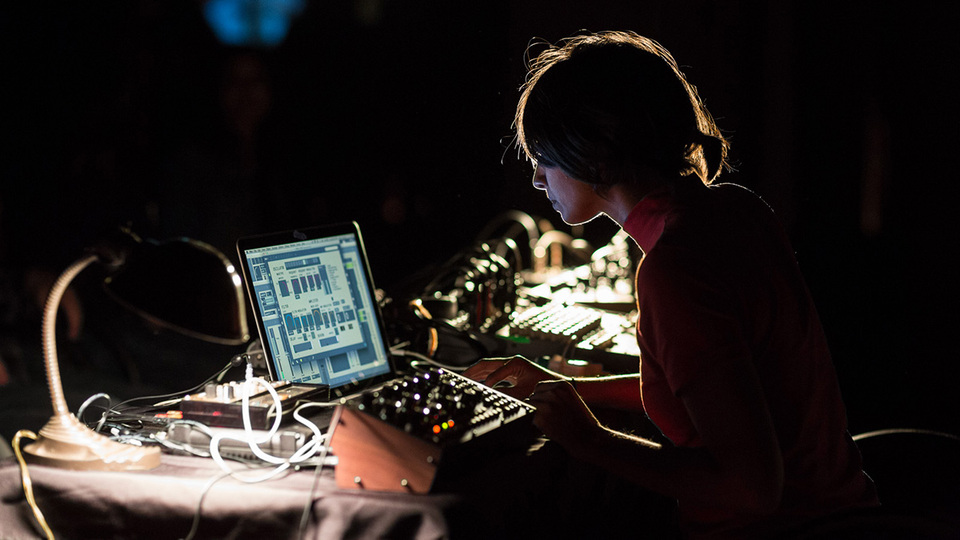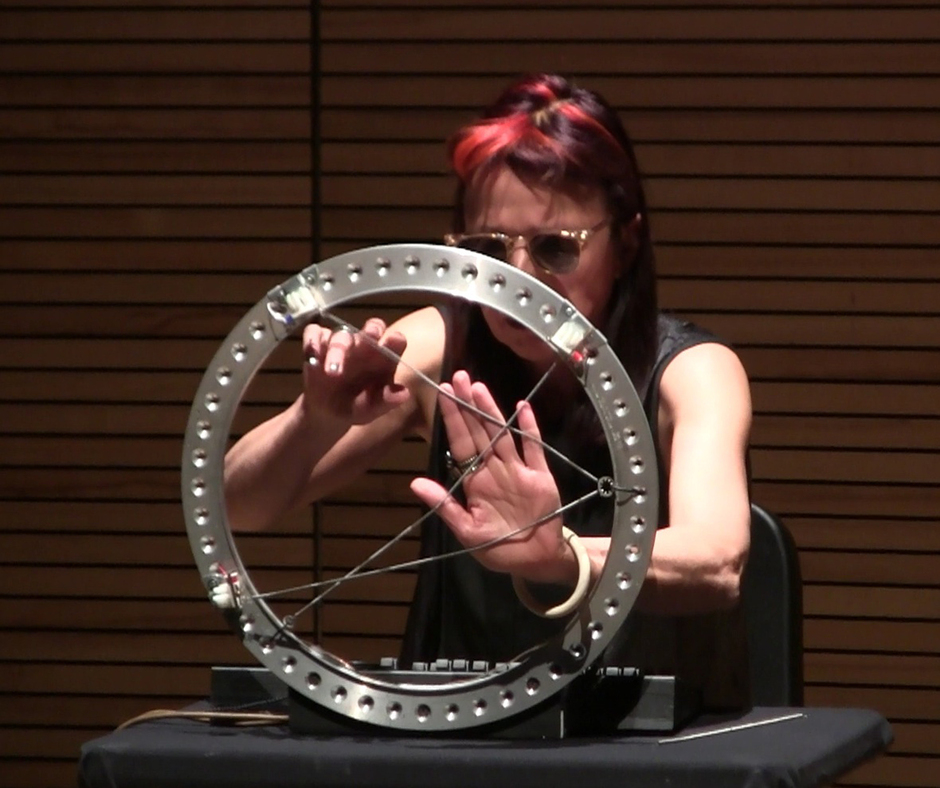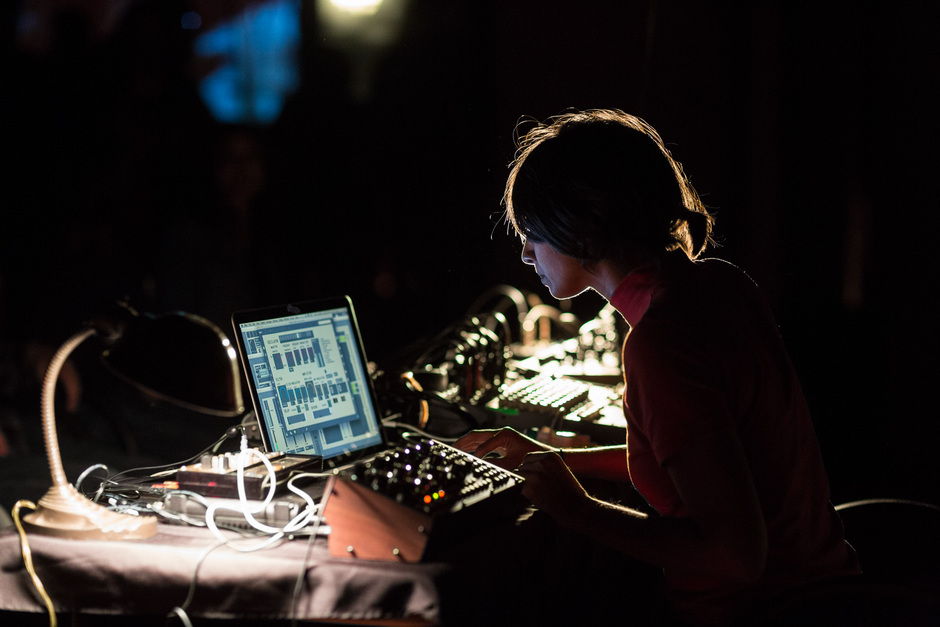
Laetitia Sonami + Asha Tamirisa
With Of lands and lines, Bay Area electronic music pioneer Laetitia Sonami explores the Spring Spyre, a neural network instrument created in collaboration with technologist Rebecca Fiebrink. Focusing on the shift between place and representation, Sonami tunes the instrument in a new “prepared exploration” created specifically for the performance site at Wind River. Sharing the bill is Asha Tamirisa, whose long-form improvised performances incorporate various combinations of digital, analog, and tactile media—such as analog synthesizers, sounding objects, moving image, and generative text—and often seek to use the site of the performance as part of the instrumentation. Laetitia Sonami will close the evening with a performance of Eliane Radigue’s OCCAM IX, written for her in 2012.
This event is part of Digital Alchemy, a series of performances and discussions exploring the intertwined intellectual and ideological histories of art and technology. For admission to the full series, become a member and pick up the Digital Alchemy All-Access Pass.
Laetitia Sonami: Of lands and lines
In Of lands and lines, Sonami continues her exploration of the Spring Spyre, her new instrument based on the application of neural networks to the control of audio synthesis. The focus now is on the shift between place and representation.
Laetitia Sonami is a sound artist, performer and researcher.
Sonami’s sound performances, live-film collaborations and sound installations focus on issues of presence and participation. She has devised new gestural controllers for performance and applies new technologies and appropriated media to achieve an expression of immediacy through sound, place and objects. Best known for her unique instrument, the elbow-length lady’s glove, which is fitted with an array of sensors tracking the slightest motion of her hand and body, she has performed worldwide and earned substantial international renown.
Recent projects include the design of a new instrument, the Spring Spyre, based on the application of neural networks to real-time audio synthesis; an improvisation duo, Sparrows and Ortolans, with James Fei; and Le Corps Sonore, a fully immersive sound installation on six floors of the Rubin Museum, NYC in collaboration with Eliane Radigue and Bob Bielecki.
Upcoming projects include Peripheral Vision, a text based performance piece and a new live film project with Sue-C based on Italo Calvino Cosmicomics. Sonami has received numerous awards among which the Herb Alpert Awards in the Arts and the Foundation for Contemporary Performance Awards.
Asha Tamirisa: to ocean
Asha Tamirisa’s long-form improvised performances incorporate various combinations of digital, analog, and tactile media—such as analog synthesizers, sounding objects, moving image, and generative text—and often seek to use the site of the performance as part of the instrumentation. Most recently, historical allegories, memories, and archival materials have been finding their way into her sensorial multimedia performances. to ocean is a new long-form, cathartic improvisation combining analog and digital synthesis.
Asha Tamirisa works with sound, video, and film, and researches media histories. Asha has performed at venues such as the ICA Boston, Bitforms Gallery (NYC), has given talks at the University of Michigan, Mount Holyoke College, Oberlin College, and Wheaton College, and held residencies at The Media Archeology Lab (Boulder, CO), Perte de Signal (Montreal, CA) and I-Park Foundation (East Haddam, CT). Asha’s work has been mentioned in the Oxford Handbook of New Audiovisual Aesthetics and the 5th Edition of Electronic and Experimental Music: Technology, Music, and Culture (Routledge). Along with many colleagues, Asha co-founded OPENSIGNAL, a collective of artists concerned with the state of gender and race in electronic music and art practice. Asha has taught courses at Brown University, the Rhode Island School of Design, Girls Rock! Rhode Island, and Street Level Youth Media in Chicago. Asha recently received a PhD in Computer Music and Multimedia and an M.A. in Modern Culture and Media from Brown University, and is currently an Assistant Professor at Bates College.
Eliane Radigue: OCCAM IX
OCCAM IX inscribes itself in a larger series of compositions entitled OCCAM OCEAN created by composer Eliane Radigue for and with instrumentalists and composers. Compositions for harp, violin, viola, bass clarinet, and cello have been created with Rhodri Davis, Carol Robinson, Charles Curtis, amongst others and received critical acclaim. This ninth composition was created with Laetitia Sonami on electronics with her latest instrument, the Spring Spyre. Sonami originally studied with Radigue in France in 1976. While her music took on a very different expression through her design of unique controllers and live performance, they both remained very close. In 2011, Sonami requested Eliane to create a piece for her new instrument. Their meetings took place during the Winter 2012 in France after which Radigue gave her permission to premiere the piece in the Fall 2013. The work mode is based on an individual “image” illustrated and evoked within each solo. Each musician is guided by his or her personal “image.” This provides the essential, letting descriptive words and evocations establish a system of communication as the piece is being elaborated, and through this intuitive-instinctive process, guides the performer to the very essence of music. The process is akin to oral transmission of ancient traditional music.
Thank you to Kristina Wolfe and Douglas Swanson for sponsoring this event.
Laetitia Sonami:
Of lands and lines

In Of lands and lines, Sonami continues her exploration of the Spring Spyre, her new instrument based on the application of neural networks to the control of audio synthesis. The focus now is on the shift between place and representation.
Laetitia Sonami is a sound artist, performer and researcher.
Sonami’s sound performances, live-film collaborations and sound installations focus on issues of presence and participation. She has devised new gestural controllers for performance and applies new technologies and appropriated media to achieve an expression of immediacy through sound, place and objects. Best known for her unique instrument, the elbow-length* lady’s glove*, which is fitted with an array of sensors tracking the slightest motion of her hand and body, she has performed worldwide and earned substantial international renown.
Recent projects include the design of a new instrument, the Spring Spyre, based on the application of neural networks to real-time audio synthesis; an improvisation duo, Sparrows and Ortolans, with James Fei; and Le Corps Sonore, a fully immersive sound installation on six floors of the Rubin Museum, NYC in collaboration with Eliane Radigue and Bob Bielecki.
Upcoming projects include Peripheral Vision, a text based performance piece and a new live film project with Sue-C based on Italo Calvino Cosmicomics. Sonami has received numerous awards among which the Herb Alpert Awards in the Arts and the Foundation for Contemporary Performance Awards.
Asha Tamirisa:
to ocean

Asha Tamirisa will perform her piece to ocean, a long-form improvisation in which she explores combinations of digital, analog, and tactile media—such as analog synthesizers, sounding objects, moving image, and generative text.
Asha Tamirisa’s long-form improvised performances incorporate various combinations of digital, analog, and tactile media—such as analog synthesizers, sounding objects, moving image, and generative text—and often seek to use the site of the performance as part of the instrumentation. Most recently, historical allegories, memories, and archival materials have been finding their way into her sensorial multimedia performances.
Asha Tamirisa works with sound, video, and film, and researches media histories. Asha has performed at venues such as the ICA Boston, Bitforms Gallery (NYC), has given talks at the University of Michigan, Mount Holyoke College, Oberlin College, and Wheaton College, and held residencies at The Media Archeology Lab (Boulder, CO), Perte de Signal (Montreal, CA) and I-Park Foundation (East Haddam, CT). Asha’s work has been mentioned in the Oxford Handbook of New Audiovisual Aesthetics and the 5th Edition of Electronic and Experimental Music: Technology, Music, and Culture (Routledge). Along with many colleagues, Asha co-founded OPENSIGNAL, a collective of artists concerned with the state of gender and race in electronic music and art practice. Asha has taught courses at Brown University, the Rhode Island School of Design, Girls Rock! Rhode Island, and Street Level Youth Media in Chicago. Asha recently received a PhD in Computer Music and Multimedia and an M.A. in Modern Culture and Media from Brown University, and is currently an Assistant Professor at Bates College.
Eliane Radigue:
OCCAM IX
OCCAM IX inscribes itself in a larger series of compositions entitled OCCAM OCEAN created by composer Eliane Radigue for and with instrumentalists and composers. Compositions for harp, violin, viola, bass clarinet, and cello have been created with Rhodri Davis, Carol Robinson, Charles Curtis, amongst others and received critical acclaim. This ninth composition was created with Laetitia Sonami on electronics with her latest instrument, the Spring Spyre. Sonami originally studied with Radigue in France in 1976. While her music took on a very different expression through her design of unique controllers and live performance, they both remained very close. In 2011, Sonami requested Eliane to create a piece for her new instrument. Their meetings took place during the Winter 2012 in France after which Radigue gave her permission to premiere the piece in the Fall 2013. The work mode is based on an individual “image” illustrated and evoked within each solo. Each musician is guided by his or her personal “image.” This provides the essential, letting descriptive words and evocations establish a system of communication as the piece is being elaborated, and through this intuitive-instinctive process, guides the performer to the very essence of music. The process is akin to oral transmission of ancient traditional music.
Éliane Radigue (b. 1932) is a pioneering French composer of undulating continuous music marked by patient, virtually imperceptible transformations that purposefully unfold to reveal the intangible, radiant contents of minimal sound—its partials, harmonics, subharmonics and inherent distortions. As a student and assistant to musique concrète pioneers Pierre Schaeffer and Pierre Henry in the ‘50s and ‘60s, Radigue mastered tape splicing techniques, but preferred the creation of fluid, delicately balanced feedback works to the spasmodic dissonance of her teachers’ music. Finding peers among minimalist composers in America, Radigue began working with synthesis in 1970, eventually discovering the ARP 2500 synthesizer, which she would use exclusively for her celebrated electronic works to come. With remarkable restraint, Radigue spent years on each electronic piece, painstakingly assembling series of subtle, pulsating ARP recordings to be later mixed meticulously into hourlong suites of precise, perpetual mutation, including masterpieces Trilogie de la mort and Adnos I-III. In 2001, Radigue adapted an early feedback work to live performance on electric bass, Elemental II, and in 2004, with the encouragement of ongoing collaborator Charles Curtis, she permanently abandoned electronics for acoustic composition, beginning with Naldjorlak for solo cello, composed for Curtis. As within each individual work, Radigue has maintained an obstinate focus throughout the flow of her career, her dedication to the materiality of sound earning her numerous accolades and ensuring her place as one of the most important composers of our time.
(From [The Lab](https://www.thelab.org/projects/2019/9/10/liane-radigue-occam-ocean).)

Asha Tamirisa’s long-form improvised performances incorporate various combinations of digital, analog, and tactile media—such as analog synthesizers, sounding objects, moving image, and generative text—and often seek to use the site of the performance as part of the instrumentation. Most recently, historical allegories, memories, and archival materials have been finding their way into her sensorial multimedia performances.
Asha Tamirisa works with sound, video, and film, and researches media histories. Asha has performed at venues such as the ICA Boston, Bitforms Gallery (NYC), has given talks at the University of Michigan, Mount Holyoke College, Oberlin College, and Wheaton College, and held residencies at The Media Archeology Lab (Boulder, CO), Perte de Signal (Montreal, CA) and I-Park Foundation (East Haddam, CT). Asha’s work has been mentioned in the Oxford Handbook of New Audiovisual Aesthetics and the 5th Edition of Electronic and Experimental Music: Technology, Music, and Culture (Routledge). Along with many colleagues, Asha co-founded OPENSIGNAL, a collective of artists concerned with the state of gender and race in electronic music and art practice. Asha has taught courses at Brown University, the Rhode Island School of Design, Girls Rock! Rhode Island, and Street Level Youth Media in Chicago. Asha recently received a PhD in Computer Music and Multimedia and an M.A. in Modern Culture and Media from Brown University, and is currently an Assistant Professor at Bates College.

Laetitia Sonami is a sound artist, performer and researcher.
Sonami’s sound performances, live-film collaborations and sound installations focus on issues of presence and participation. She has devised new gestural controllers for performance and applies new technologies and appropriated media to achieve an expression of immediacy through sound, place and objects. Best known for her unique instrument, the elbow-length* lady’s glove*, which is fitted with an array of sensors tracking the slightest motion of her hand and body, she has performed worldwide and earned substantial international renown.
Recent projects include the design of a new instrument, the Spring Spyre, based on the application of neural networks to real-time audio synthesis; an improvisation duo, Sparrows and Ortolans, with James Fei; and Le Corps Sonore, a fully immersive sound installation on six floors of the Rubin Museum, NYC in collaboration with Eliane Radigue and Bob Bielecki.
Upcoming projects include Peripheral Vision, a text based performance piece and a new live film project with Sue-C based on Italo Calvino Cosmicomics. Sonami has received numerous awards among which the Herb Alpert Awards in the Arts and the Foundation for Contemporary Performance Awards.
